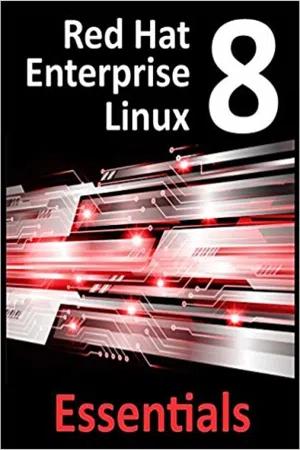
- 266 pages
- English
- ePUB (mobile friendly)
- Available on iOS & Android
Red Hat Enterprise Linux 8 Essentials
About This Book
Master the basics of the most widely used enterprise level operating systemsKey Features• Review the Red Hat Enterprise 8 Linux environment• Install and administer Red Hat Enterprise Linux 8• Share RHEL 8 files with remote systemsBook DescriptionRed Hat Enterprise Linux 8 is one of the most secure and dependable operating systems available. For this reason, the ambitious system or network engineer will find a working knowledge of Red Hat Enterprise 8 to be an invaluable advantage in their respective fields.This book, now updated for RHEL 8.1, begins with a history of Red Enterprise Linux and its installation. You will be virtually perform remote system administration tasks with cockpit web interface and write shell scripts to maintain server-based systems without desktop installation. Then, you will set up a firewall system using a secure shell and enable remote access to Gnome desktop environment with virtual network computing (VNC). You'll share files between the Red Hat Enterprise Linux 8 (RHEL 8) and Windows System using Samba client and NFS. You will also run multiple guest operating systems using virtualization and Linux containers, and host websites using RHEL 8 by installing an Apache web server. Finally, you will create logical disks using logical volume management and implement swap space to maintain the performance of a RHEL 8 system.By the end of this book, you will be armed with the skills and knowledge to install the RHEL 8 operating system and use it expertly.What you will learn• Install Gnome desktop environment to manage multiple workspaces• Access multiple servers simultaneously using cockpit web interface• Manage network configuration using NetworkManager• Configure firewall rules using firewall commands• Use Virsh tool to manage kernel-based virtual machine• Manage disk space by logical volume management and swap spaceWho This Book Is ForRed Hat Enterprise Linux 8 Essentials is for network engineers and system administrators who are new to the Red Hat Linux environment. Some working knowledge of Linux commands is recommended
Frequently asked questions
Information
Table of contents
- 1. Introduction
- 2. A Brief History of Red Hat Linux
- 3. Installing RHEL 8 on a Clean Disk Drive
- 4. Dual Booting RHEL 8 with Windows
- 5. Allocating Windows Disk Partitions to RHEL 8
- 6. A Guided Tour of the GNOME 3 Desktop
- 7. An Overview of the RHEL 8 Cockpit Web Interface
- 8. Using the Bash Shell on RHEL 8
- 9. Managing RHEL 8 Users and Groups
- 10. Understanding RHEL 8 Software Installation and Management
- 11. Configuring RHEL 8 systemd Units
- 12. RHEL 8 Network Management
- 13. Basic RHEL 8 Firewall Configuration with firewalld
- 14. Configuring SSH Key-based Authentication on RHEL 8
- 15. RHEL 8 Remote Desktop Access with VNC
- 16. Displaying RHEL 8 Applications Remotely (X11 Forwarding)
- 17. Using NFS to Share RHEL 8 Files with Remote Systems
- 18. Sharing Files between RHEL 8 and Windows Systems with Samba
- 19. An Overview of Virtualization Techniques
- 20. Installing KVM Virtualization on RHEL 8
- 21. Creating KVM Virtual Machines using Cockpit and virt-manager
- 22. Creating KVM Virtual Machines with virt-install and virsh
- 23. Creating a RHEL 8 KVM Networked Bridge Interface
- 24. Managing KVM using the virsh Command-Line Tool
- 25. An Introduction to Linux Containers
- 26. Working with Containers on RHEL 8
- 27. Setting Up a RHEL 8 Web Server
- 28. Configuring a RHEL 8 Postfix Email Server
- 29. Adding a New Disk Drive to a RHEL 8 System
- 30. Adding a New Disk to a RHEL 8 Volume Group and Logical Volume
- 31. Adding and Managing RHEL 8 Swap Space
- Index